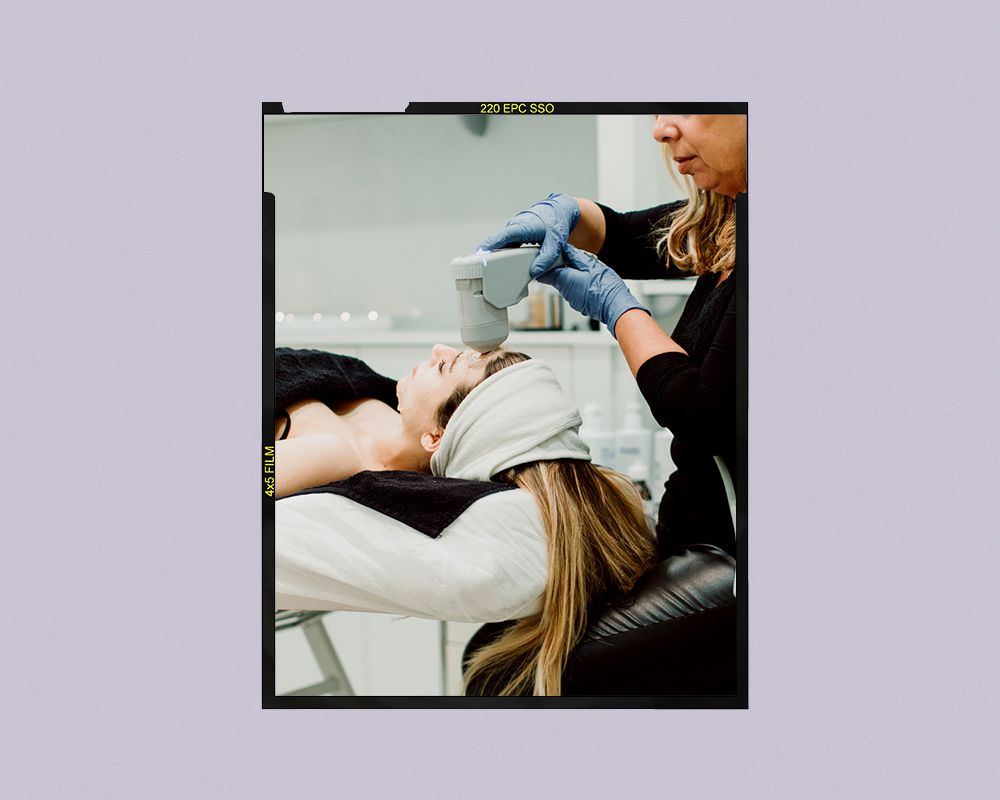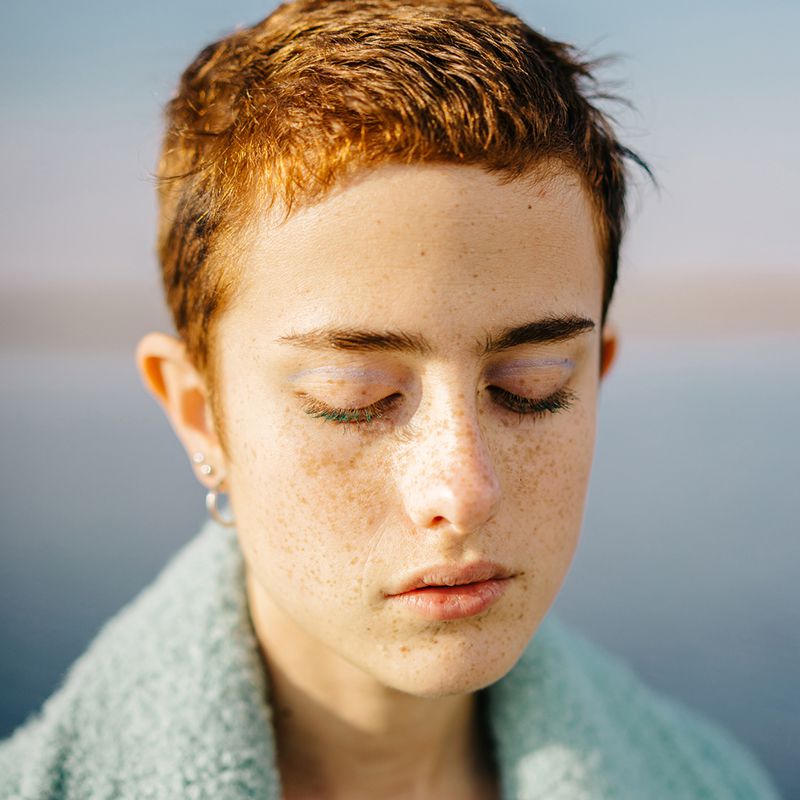5 Ways to Treat Facial Spider Veins

When you think of obvious signs of aging, the first things to come to mind are fine lines and wrinkles. Of course, plenty of other signs, like dark spots, loss of volume, a lackluster complexion, and spider veins, also exist. Today, we’re here to talk about the latter.
People often think that spider veins—blood vessels that you can see through the surface of the skin—only occur on the backs of kneecaps. In reality, they can appear on your face, too.
“Facial spider veins—also known as telangiectasias—are dilated blood vessels commonly seen on the sides of the nose, cheeks, and chin, measuring between 0.5-1mm,” explains board-certified, New York-licensed Physician Assistant, Gabrielle Garritano, who is the founder and CEO of JECT. “Telangiectasias can be disease-associated (auto-immune diseases); however, more commonly we see them in patients who suffer from rosacea, chronic topical hydrocortisone use, and chronic sun exposure.”
Fortunately, just because facial spider veins exist doesn’t mean that they have to last forever. Ahead, discover the five best ways to treat facial spider veins, according to Garritano and board-certified dermatologist Dendy Engelman.
Meet the Expert
- Gabrielle Garritano is a New York-licensed physician assistant and the founder and CEO of JECT.
- Dendy Engelman is a New York City-based board-certified dermatologist and a member of the Byrdie Review Board.
01
of 05
Vbeam Prima Pulsed Dye Laser
Engelman applauds the Vbeam Prima Pulsed Dye Laser as one of the most successful treatments for spider veins and rosacea. “The Vbeam laser treatment uses intense bursts of light set at a frequency that blood vessels, but not skin tissue, can absorb, to break down blood vessels without damaging the surrounding areas,” Engelman explains.
The treatment, which can also be used to address dark spots, wrinkles, and acne, is performed in a dermatologist’s office and typically costs $500 or more per session (precise estimates are based upon your location).
02
of 05
IPL (Intense Pulsed Light)
Commonly referred to as a Photofacial, IPL uses broad-spectrum light, which Garritano says helps improve brown and dark spots from sun exposure, rosacea, age spots, and telangiectasias. IPL can address all of these concerns using the many wavelengths of scattered light to seal off and dissolve blood vessels.
A typical IPL treatment takes about 20 minutes and comes with little to no downtime, making it an ideal lunchtime treatment.
As effective as IPL is, Engelmaan doesn’t recommend it for patients with darker skin tones, as the light also targets the melanin in the skin, which can put deeper-toned patients at risk for developing hyperpigmentation.
03
of 05
Nd:YAG Laser
Catering to the dark skin tones which aren’t well-served by IPL, the Nd:YAG laser is a worthy consideration. “This 1064-nanometer wavelength laser is a great option for deeper skin tones because it is not as easily absorbed by melanin as other laser wavelengths, and therefore has a lower chance of causing damage,” Engelman explains.
The Nd:YAG laser works by bypassing the epidermis (the outermost layer of the skin) and doesn’t rely on pigmentation differences to deliver results. As a result, Engelman says that it’s a safe option for those with more melanin in their skin (i.e., darker skin types) who are looking to address facial spider veins.
Like Vbeam and IPL, the Nd: YAG laser is an in-office treatment that will cost you around $500 per session, depending on where you live and your dermatologist’s level of expertise.
04
of 05
KTP Laser
Like the Vbeam Prima laser, the KTP laser is designed to address skin concerns like facial spider veins (as well as birthmarks and freckles) without harming the surrounding skin tissue. A single treatment takes about 15 minutes long, offers little to no downtimes, and typically only requires two treatments for full results. And, at around $400 per session, that makes KTP one of the most affordable ways to treat facial spider veins.
05
of 05
Retinoids/Retinol
While in-office treatments are often the most effective measures for addressing facial spider veins, some at-home products exist to target the appearance of the tiny visible veins as well—namely, retinoids. While not as effective as a dermatologist treatment, Engelmaan says that applying a retinoid/retinol cream is an easy and much more affordable way to help reduce the appearance of facial spider veins.
“Retinoids (and retinol) promote skin cell turnover and stimulate collagen synthesis, and are known for minimizing signs of aging like hyperpigmentation and fine lines,” she explains. “You can find over-the-counter creams and serums at different levels of strength for as little as around $12.”
Hoping to kick things off in the most affordable way? Keep reading for five retinol products that might be the answer to your skincare prayers.
:max_bytes(150000):strip_icc()/Differingel-0f7a3ee58cc64cf5a4111cd8f31c4337.jpg)
Differin
Acne Treatment Gel
$28.99
Say hello to the first and only FDA-approved full prescription-strength retinoid. While designed for folks with acne, it can help those struggling with facial spider veins, thanks to its retinol content.
:max_bytes(150000):strip_icc()/DrunkElephantA-PassioniRetinolCream-7e6794f2daf14784a2123e3906106fef.png)
Drunk Elephant
A-Passioni™ Retinol Cream
$$74
Over 178,000 Sephora shoppers adore this retinol serum thanks to its gentle-yet-effective nature. Made with 1% retinol, it’s especially helpful for addressing texture and tone, along with dark spots and loss of volume.
:max_bytes(150000):strip_icc()/RoCRetinol-2d8d2f38f99944338014d835034656c3.jpg)
RoC
Retinol Correxion Deep Wrinkle Night Cream
$$24.99
One of Engelman’s all-time favorite OTC retinol products, the RoC Night Cream not only addresses fine lines and wrinkles but deeply hydrates skin, too. In just 12 weeks, you can expect a noticeable reduction in wrinkles (and potentially facial spider veins) by up to 50 percent. Impressive, no?










